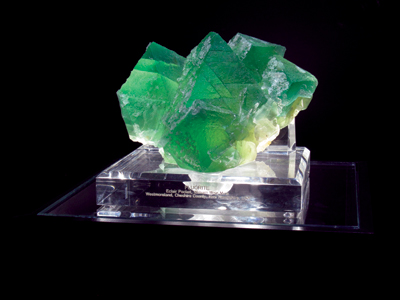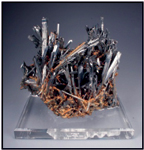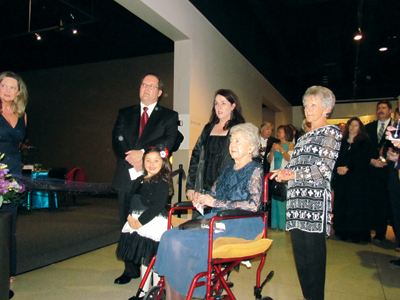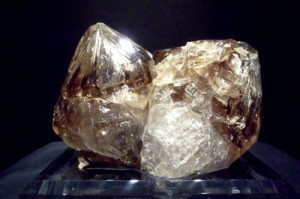 The Permian Basin Petroleum Museum unveiled some resplendent rocks in a dazzling exhibition, the Judson Mineral Gallery.
The Permian Basin Petroleum Museum unveiled some resplendent rocks in a dazzling exhibition, the Judson Mineral Gallery.
The woman peered intently through the glass at each sparkling rock and finally commented, “This exhibit is as good as the one in Houston.”
She was among the crowd attending a gala event at the Permian Basin Petroleum Museum in late November to celebrate the opening of the Judson Mineral Gallery. The 90 mineral specimens that are part of the Edward H. Judson Memorial Mineral Collection not only surprised the museum supporters that night—they are astounding visitors every day.
If rocks could talk, these specimens would have volumes to tell. Coming from locations around the world, they have passed through many hands before arriving in Midland.
Some of the minerals first appeared at the Petroleum Museum a few years ago when their owner, Don Judson, allowed them to be part of the Gem and Mineral Society’s Exhibit. “The Museum worked with the Gem and Mineral Society to host an exhibit a few years back,” said Executive Director Kathy Shannon. “Don asked about adding some big pieces to the exhibit and we said ‘yes.’”
Since then, Judson has “been an active part in developing the Museum’s role in appreciating and understanding the role of minerals,” she added. 
Then came a series of incidents that melded into the opening of the Judson Mineral Gallery with the mineral collection to honor Don’s late father, Edward H. Judson.
Edward graduated from the University of Oklahoma with a degree in petroleum engineering and went to work for Shell Oil Co. In the early 1950s, Judson joined a couple of oil operators to form Martin, Williams, and Judson in Midland. The firm continued until the late 1990s. Edward passed away in 2008.
During his life, Edward “had done some collecting of minerals,” said his daughter, Judy Judson.
Her brother, Don, inherited that love for minerals. As an avid collector, he often attends the Tucson Gem and Mineral Show, known as the largest gem and mineral show in the United States. He has developed numerous contacts in the mineral world and through one of those contacts Don learned that part of the Marvin Rausch Collection would be up for sale, Julie related.
That’s when the idea of purchasing part of that collection and donating it to the Petroleum Museum took shape. His mother, Marilyn Judson, recalled, “It [the Rausch Collection] was such an outstanding collection that we wanted to have Midland have part of it. We went out to Arizona to look at the collection. With Don’s knowledge of minerals, we were able to pick what we felt were the most important ones.”
 The family decided to honor the late Edward H. Judson through this contribution to a mineral gallery. “Mother was instrumental in moving this forward,” Judy said. “She and my brother had a vision of how the gallery would look.”
The family decided to honor the late Edward H. Judson through this contribution to a mineral gallery. “Mother was instrumental in moving this forward,” Judy said. “She and my brother had a vision of how the gallery would look.”
When Judson offered to allow the minerals to be displayed at the Museum, “We thought it was a perfect fit for us since we are a geological museum,” Ms. Shannon said.
At first, the Museum agreed to build display cases for the minerals. Then the idea of a permanent gallery evolved. Ms. Shannon consulted with the Houston Museum of Natural History on design and display ideas. The Judson family also investigated museums and mineral collections around the country for ideas.
“I give my brother credit for pulling it together,” Judy said. “He had a vision for how the display cases would look and for getting the appropriate lighting that would be safe for the minerals. He wanted the display cases designed so the minerals would pop out at visitors.”
She also noted the Petroleum Museum worked closely with her brother on the gallery’s design, display cases, and lighting. Meanwhile, a grant from the Wayne and Jo Ann Moore Charitable Foundation assisted with the Museum’s construction costs.
The Judson family hopes the collection will “spark an interest among people in geology and minerals,” Judy said. “We see an educational component to this” along with giving the public an exhibit that will awaken the senses to a different kind of beauty. “This is nature’s art and we very much want to share this with anyone who is interested in looking at it.”
Sister Linda Judson added, “In our daily lives we don’t see the incredible variety and beauty that God has created.” This exhibit, hopefully, will open the eyes of people young and old to the idea that beautiful art can be seen in these rocks.
And each one has a story. A grant from the F. Marie Hall Foundation will allow the Museum to create educational pieces about the collection, noted the executive director.
The late Marvin Rausch, from whose collection many of these minerals came, is himself a story, as related in the May 5, 2008, edition of the Springfield Republican. He received a doctorate in organic chemistry in 1955, served in the U.S. Air Force, worked with Nobel prize-winning chemist Ernst Otto Fischer, and eventually became a professor of chemistry at University of Massachusetts in Amherst. Rausch loved mineralogy and built one of the best private mineral collections in New England. He often visited the Tucson Gem and Mineral Show. He passed away in 2008 and part of his large collection is on display at the University of Massachusetts Geosciences Department. One part of his large collection is what the Judson family purchased.
Along with the collection come stories of some of the minerals. The sulfur mineral on exhibit is one example. Found at Girgenti, Sicily, the mineral was at one time part of the Charles Spang Collection and was on display in 1833 at the American Museum of Natural History in New York City. The collection then began to change hands until part of it was acquired by J.P. Morgan. However, there is no record of how Rausch obtained the sulfur mineral that is part of the collection purchased by the Judson family.
Other minerals on display in the Judson Mineral Gallery include barite from Xichang, China; chalcopyrite and calcite from Russia; dioptase from Kazachstan; malachite from Democratic Republic of Congo, Africa; pyrite and quartz from Peru; and fluorite from Cheshire County, New Hampshire.
A quartz var. amethyst came from the Reel Mine in Lincoln County, North Carolina. The story accompanying this mineral notes that Rausch purchased it in 1998 at the Denver Gem and Mineral Show. A dam was built and the mine where it was found is now flooded.
The scolecite on apophyllite mineral came from Maharascha, India. Rausch purchased it in 1990 at the Munich, Germany, gem and mineral show. “It is an unbelievable specimen with 2 inch-plus radiating gemmy white translucent crystals. It looks like a pin cushion,” according to the notes.
 The woman attending the gala event wasn’t alone in her assessment of the gallery. Since the opening, “people really are amazed at the minerals. It is truly a beautiful mineral gallery,” noted Ms. Shannon. “There has been an overwhelmingly positive response by the public.”
The woman attending the gala event wasn’t alone in her assessment of the gallery. Since the opening, “people really are amazed at the minerals. It is truly a beautiful mineral gallery,” noted Ms. Shannon. “There has been an overwhelmingly positive response by the public.”
The Permian Basin Petroleum Museum is open 10 a.m. to 5 p.m. Monday through Saturday and 2 to 5 p.m. Sunday.










